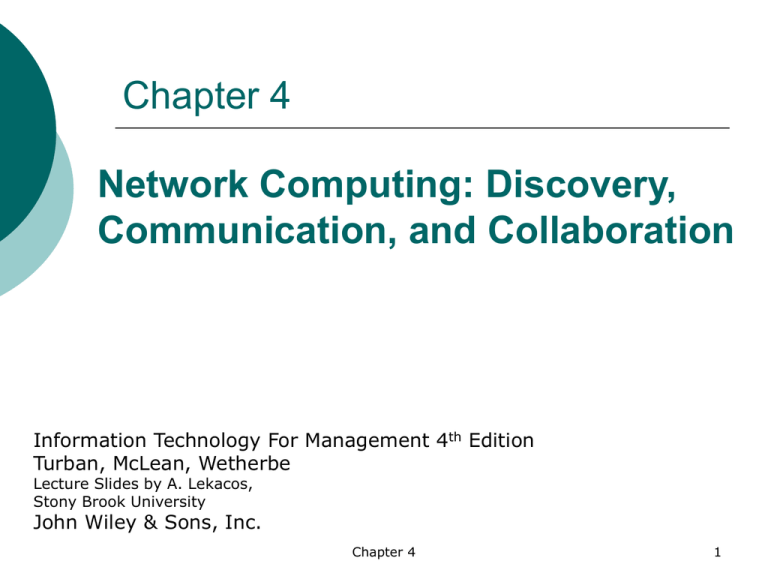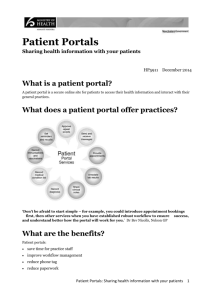
Chapter 4
Network Computing: Discovery,
Communication, and Collaboration
Information Technology For Management 4th Edition
Turban, McLean, Wetherbe
Lecture Slides by A. Lekacos,
Stony Brook University
John Wiley & Sons, Inc.
Chapter 4
1
Chapter Objectives
Understand the concepts of the Internet and the Web,
their importance, and their capabilities.
Understand the role of intranets, extranets, and
corporate portals for organizations.
Identify the various ways in which communication is
executed over the Internet.
Demonstrate how people collaborate over the Internet,
intranets, and extranets using various supporting tools,
including voice technology and teleconferencing.
Describe groupware capabilities.
Describe and analyze the role of e-learning and distance
learning.
Analyze telecommuting (teleworking) as a techno-social
phenomenon.
Consider ethical and integration issues related to the use
of network computing.
Chapter 4
2
Network Computing
The vast web of electronic networks, referred to as the
information superhighway or Internet links the computing
resources of businesses, government, and educational
institutions using a common computer communication protocol,
TCP/IP. The World Wide Web---the
Web--is the most widely
Domain
Name Ser ver
used application on the
Internet.
URL = protocol://hostComputeror IP/path
Cl ient
Discovery
Collaboration
Communication
Web Ser ver
The HTTP protocol (HyperText
Transfer Protocol) specifies the rules
for communication between a Web
browser (client) and a Web server.
Intranets
Extranets
Request is made for a
page through a Web
Browser (IE. NS)
Ser ver
Technol ogy
Coldfusion Technology
- CFM
Appl icat ion
Ser ver
Apache Server
Java Server Pages JSP
Personal Server
Active Server Pages ASP
Internet Information
Server- IIS
DB
Chapter 4
iPlanet
3
Evolution - Network Computing
Internet
Chapter 4
4
Internet Application Categories
Discovery: Discovery involves browsing and information retrieval.
Communication: The Internet provides fast and inexpensive
Collaboration: Due to improved communication,
The Net is also used for:
communication channels that range from messages posted on online
bulletin boards to complex information exchanges among many
organizations.
electronic
collaboration between individuals and/or groups ranging from screen
sharing and teleconferencing to group support systems.
Education
Entertainment: People can access the content of newspapers,
magazines, and books. Correspond with friends and family, play
games, listen to music, view movies and other cultural events.
Work: They can download documents, do research.
Chapter 4
5
The Network Computing Infrastructure
In addition to the Internet and the Web there are two
other major infrastructures of network computing: the
intranet and the extranet
Intranet: a network designed to serve the internal
informational needs of a company, using Internet concepts
and tools.
Browsing and Search capabilities.
Support communication and collaboration.
Extranet: An extranet is an infrastructure that allows
secure communications (connects the intranets of different
organizations) among business partners over the Internet.
Enables business-to-business (B2B) transactions
Provides an interface to exchange of business forms
Chapter 4
6
The Network Computing Infrastructure
A network is designed to serve the
informational needs of a company,
using Internet concepts and tools.
Chapter 4
7
Discovery - Internet Application Categories
Through the discovery capability users can access information
located in databases all over the world. It facilitates education,
government services, entertainment, and commerce. Discovery
is done by browsing and searching static or dynamic data
sources on the Web.
Internet Software Agents
Internet-Based Web Mining
Other Discovery Aids
Toolbars
Material in Foreign Languages
Information and Corporate Portals
Chapter 4
8
Discovery - Internet Software Agents
Software agents are computer programs that carry out a set of
routine computer tasks on behalf of the user and in so doing
employ some sort of knowledge of the user’s goals
Search engines, directories, software
and intelligent agents
Web-Browsing-Assisting Agents
Frequently Asked Questions (FAQ)
Agents
Search Engines and Intelligent
Indexing Agents
Chapter 4
9
Discovery - Internet-Based Web Mining
Data mining refers to sophisticated analysis techniques for
sifting through large amounts of information to discover new
patterns and relationships.
Predictive Tools
Classification (Predefined Groups)
Regression
Time series
Descriptive Tools
Clustering (No Predefined Groups)
Summarization
Association
Sequencing
Chapter 4
10
Discovery - Other Discovery Aids
Hundreds of other search engines and discovery aids are
available
Webopedia.com
What Is? (whatis.com)
eBizSearch (gunther.smeal.psu.edu)
Elibrary (ask.library.com)
Howstuffworks.com.
Findarticles.com
Chapter 4
11
Discovery - Toolbars
To get the most out of search engines, you may use add-on
toolbars and special software.
Google Toolbar (toolbar.google.com)
Copernic Agent Basic (copernic.com)
KartOO (kartoo.com)
Yahoo Companion (companion.yahoo.com)
Grokker (groxis.com)
Chapter 4
12
Discovery - Information in Foreign Languages
There is a huge amount of information on the Internet in
languages that you may not know. Automatic translation of Web
pages is an application offered by many vendors. However, not
all automatic translations are equally good, so evaluation of
these products is needed.
WorldPoint Passport (worldpoint.com)
Babel Fish Translation (world.altavista.com)
AutoTranslate (offered in Netscape browser)
trados.com
translationzone.com
Chapter 4
13
Discovery - Information & Corporate Portals
A portal is a Web-based personalized gateway to information
and knowledge in network computing. It attempts to address
information overload by providing one screen from which we do
all our work on the Web. Thus eliminating retrieval time spent
on integrating disparate IT systems.
Commercial (public) portals offer content for
diverse communities and are the most popular
portals on the Internet. Examples are:
yahoo.com
lycos.com
msn.com
Publishing portals are intended for communities
with specific interests. Examples are:
techweb.com
zdnet.com
Chapter 4
14
Discovery - Information & Corporate Portals (continued)
Personal portals target specific filtered information
for individuals.
Affinity portals support communities such as hobby
groups or a political party
Mobile portals are portals accessible from mobile
devices.
Voice portals are Web portals with audio interfaces,
which enables them to be accessed by a standard or
cell phone.
AOLbyPhone
tellme.com
i3mobile.com
Chapter 4
15
Discovery - Information & Corporate Portals (continued)
Corporate portals provide single-point access to specific
enterprise information and applications available on the
Internet, intranets, and extranets to employees, business
partners, and customers. They are also known as enterprise
portals or enterprise information portals.
Suppliers portals: Using corporate portals, suppliers can
mange their own inventories online.
Customers portals: Customers can use a customerfacing portal for viewing products and services and
placing orders, which they can later self-track.
Employees portals: Such portals are used for training,
dissemination of news and information, and workplace
discussion groups.
Supervisors’ portals: These portals, sometimes called
workforce portals, enable managers and supervisors to
control the entire workforce management process– from
budgeting to scheduling workforce.
Chapter 4
16
Discovery - Information & Corporate Portals (continued)
Corporate portals
Chapter 4
17
Communication - Internet Application Categories
People exchange and share information by sending and receiving
messages, documents, forms and files. This informationprocessing supports the organization and the transaction of
business. Communications can involve one or several ITsupported media, such as text, voice, graphics, radio, pictures,
and animation. Using different media increases the effectiveness
of a message, expedites learning, and enhances problem solving.
Electronic Mail
Web-Based Call Centers
Electronic Chat Rooms
Voice Communication
Weblogging (Blogging)
Chapter 4
18
Collaboration - Internet Application Categories
Collaboration refers to the mutual efforts of two or more
individuals or groups to perform activities in order to accomplish
certain tasks. These tasks range from designing products and
documents, to teaching, to executing complementary subtasks, to
working with customers, suppliers, and other business partners.
In an effort to improve productivity and competitiveness
collaboration can be supported electronically.
Virtual collaboration (e-collaboration): the use
of digital technologies that enable organizations or
individuals to collaborative
Collaborative commerce (c-commerce):
collaboration among business partners
Supply chains
Dealer/Partner Networks
Product Networks
Chapter 4
19
Collaboration – Tools (Workflows)
Workflow Technologies: the movement of information
through the sequence of steps that make up an
organization’s work procedures or business processes.
Workflow management is the automation of workflows
from start to finish, including all exception conditions.
Workflow systems are business process automation
tools (software programs) that automate almost any
information-processing task.
Workflow applications:
Collaborative workflow: addresses project-oriented
and collaborative types of processes.
Production workflow: addresses mission-critical,
transaction-oriented, high volume processes.
Administrative workflow: is cross between
collaborative and production workflows.
Chapter 4
20
Collaboration – Tools (Groupware)
Software products that support groups of people who share a
common task or goal and who collaborate on its accomplishment.
Groupware implies the use of networks to connect people, even if
the people are in the same room.
Electronic Meeting Systems attempt to improve face-toface meetings with their electronic counter-part.
Electronic Teleconferencing (Teleconferencing) is the use
of electronic communication that allows two or more people
at different locations to have a simultaneous conference.
Video Teleconferencing (videoconference), participants in one
location can see participants at other locations. Data (data
conferencing) can also be sent along with voice and video
making it possible to work on documents together.
Web Conferencing is Videoconferencing solely conducted on the
Internet
Chapter 4
21
Collaboration – Tools (Groupware) (continued)
Real-time collaboration (RTC) Tools: help companies bridge
time and space to make decisions and to collaborate on projects.
RTC tools support synchronous communication of graphical and
text-based information.
Interactive Whiteboards work like the “physical world”
whiteboards with markers and erasers, except instead of one
person standing in front of a meeting room drawing on the
whiteboard, all participants can join in.
Screen Sharing software, allows group members to work
on the same document, which is shown on the PC screen of
each participant.
Instant video, is a kind of real time chat room that allows
you to see the person you are communicating with.
Chapter 4
22
Collaboration – Tools (continued)
Chapter 4
23
Collaboration – (continued)
Collaborative Networks
Chapter 4
24
E-Learning – Web-based Application
Distance learning (DL) refers to situations where teachers and
students do not meet face-to-face. It can be done in different
ways. E-learning is only one form of distance learning. It provides
a new set of tools that add value to traditional learning modes. It
does not replace the classroom setting, but enhances it, taking
advantage of new content and delivery technologies.
Blackboard Inc. (blackboard.com) offers a complete
suite of enterprise software products and services that
power a total “e-education infrastructure” for schools,
colleges, universities, and other education providers.
WebCT (webct.com) provides a similar set of tools, but
with a different vision and strategy. It uses advanced
pedagogical tools to help institutions of higher
education make distance-learning courses possible.
Chapter 4
25
Telecommuting – Web-based Application
Telecommuting, or teleworking, refers to an arrangement
whereby employees can work at home, at the customer’s
premises, in special work places, or while traveling, usually using
a computer linked to their place of employment.
There are numerous non-compensatory benefits and
advantages for employees, employers, and society. The most
important being improved productivity.
Some disadvantages for the employees are increased feelings
of isolation, loss of fringe benefits, no workplace visibility,
and lack of socialization.
Disadvantages to employers are difficulties in supervising
work, potential data security problems, training costs, and
the high cost of equipping and maintaining telecommuters’
homes.
Chapter 4
26
MANAGERIAL ISSUES
Security of communication. Communication via networks raises the issue of the
integrity, confidentiality, and security of the data being transferred. The protection of
data in networks across the globe is not simple.
Installing digital dashboards. Many companies are installing “digital dashboards,”
which are a sort of one-way portal that are continuously updated with online displays.
The dashboard is available to employees in visible places around the company and is
also accessible from PCs, PDAs, etc. Large companies, such General Electric, believe
that the cost of the dashboards can be justified by better discovery and
communication they promote within the company.
Control of employee time and activities. To control the time that employees
might waste “surfing the Net” during working hours, some companies limit the
information that employees have access to or use special monitoring software.
Providing guidelines for employee use of the Internet is a simple but fairly effective
approach.
How many portals? A major issue for some companies is how many portals to
have. Should there be separate portals for customers, suppliers, employees, for
example? Regardless of the answer, it is a good idea to integrate the separate
portals. If you build a separate portal, make sure it can be easily connected to the
others.
Chapter 4
27
MANAGERIAL ISSUES Continued
Organizational impacts. Technology-supported communication may have major
organizational impacts. For example, intranets and groupware force people to
cooperate and share information. Therefore, their use can lead to significant changes
in both organizational culture and the execution of business process reengineering.
Further impacts may be felt in corporate structure and the redistribution of
organizational power.
Telecommuting. Telecommuting is a compelling venture, but management needs to
be careful. Not all jobs are suitable for telecommuting, and allowing only some
employees to telecommute may create jealousy. Likewise, not all employees are
suitable telecommuters; some need the energy and social contact found in an office
setting.
Cost-benefit justification. The technologies described in this chapter do not come
free, and many of the benefits are intangible. However, the price of many networking
technologies is decreasing.
Controlling access to and managing the content of the material on an
intranet. This is becoming a major problem due to the ease of placing material on
an intranet and the huge volume of information. Flohr (1997) suggests tools and
procedures to manage the situation.
Chapter 4
28
Chapter 4
Copyright © 2004 John Wiley & Sons, Inc. All rights
reserved. Reproduction or translation of this work
beyond that permitted in Section 117 of the 1976
United States Copyright Act without the express
written permission of the copyright owner is
unlawful. Request for further information should be
addressed to the Permissions Department, John
Wiley & Sons, Inc. The purchaser may make backup copies for his/her own use only and not for
distribution or resale. The Publisher assumes no
responsibility for errors, omissions, or damages,
caused by the use of these programs or from the
use of the information contained herein.
Chapter 4
29






